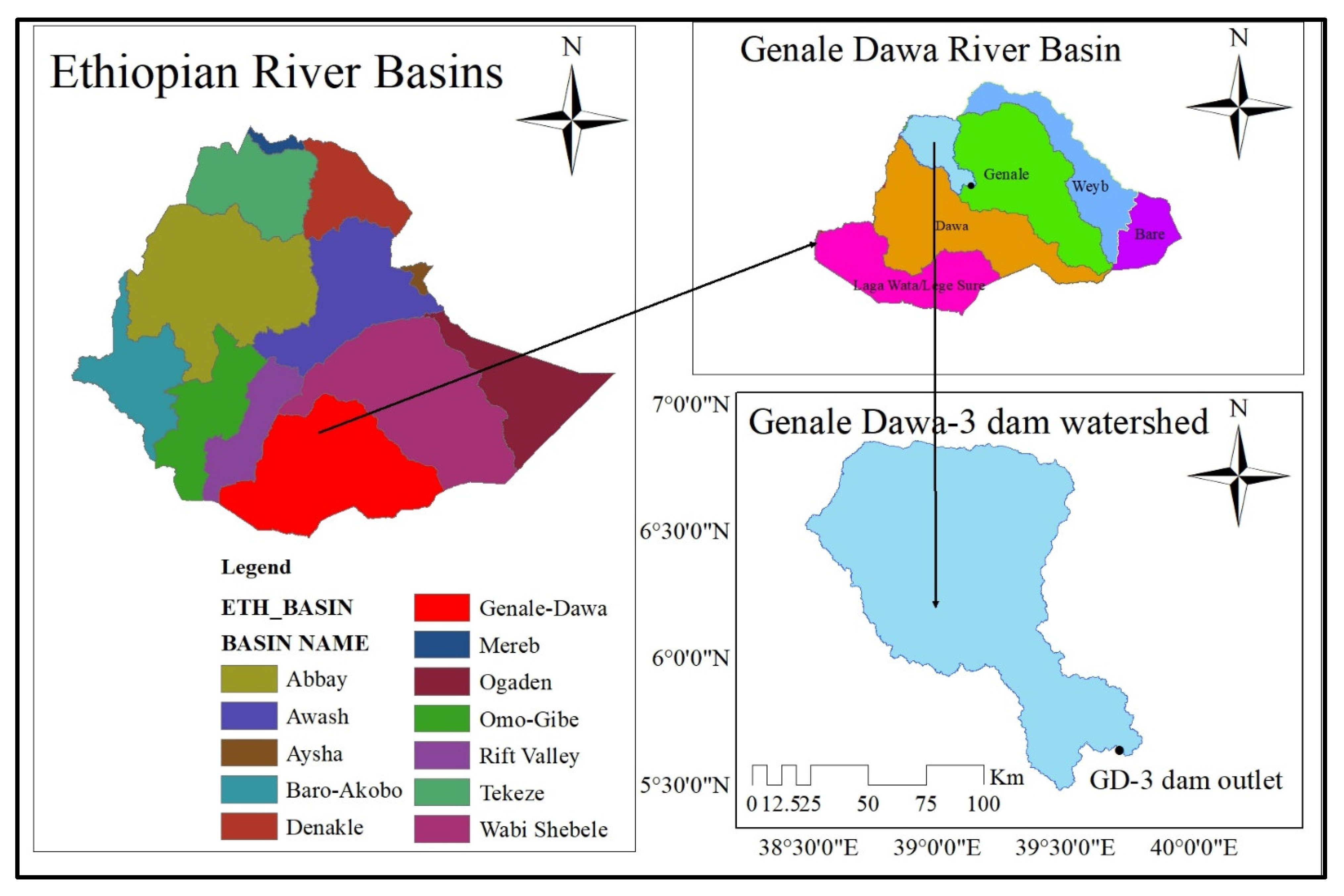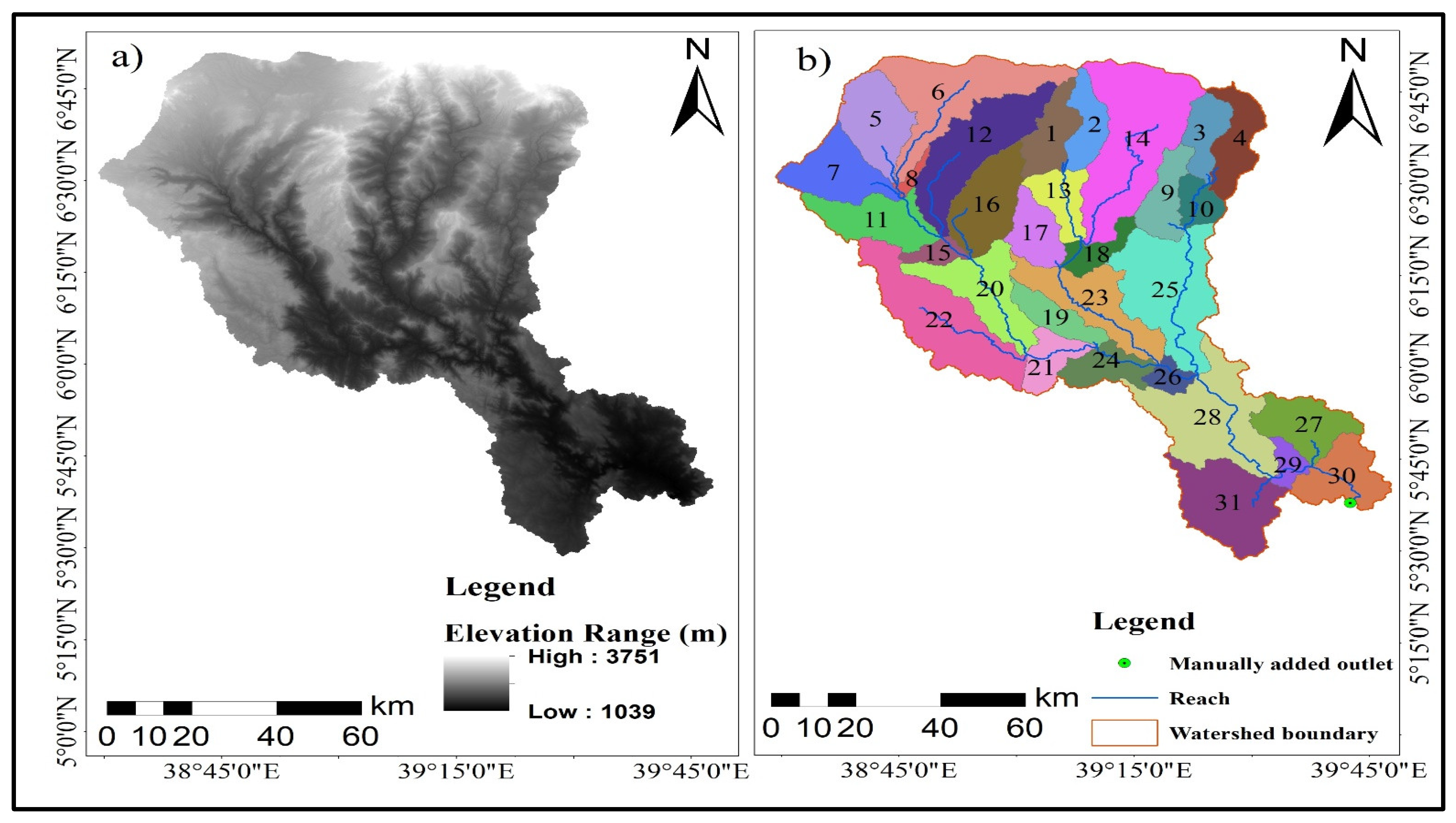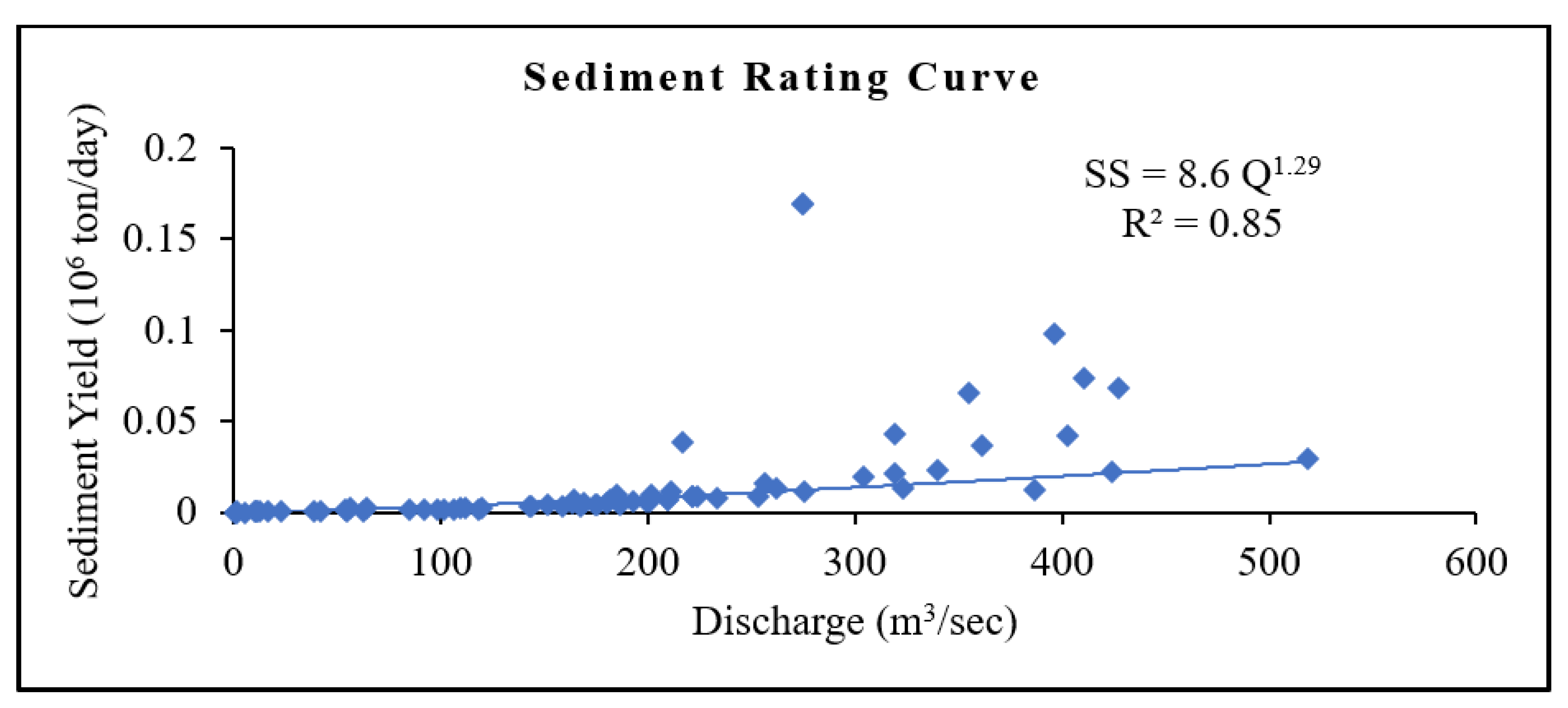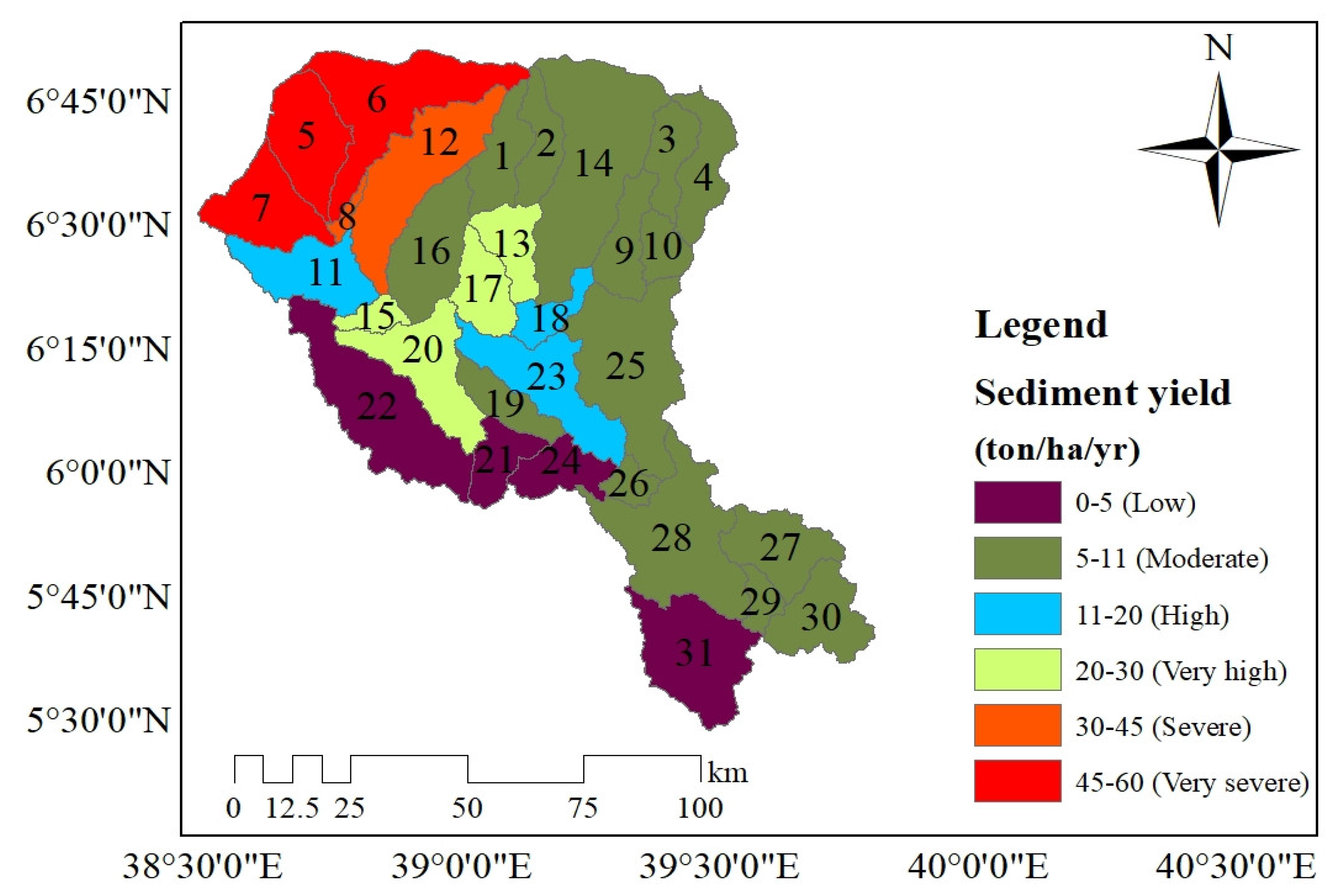2.3.1. SWAT Model Description
SWAT is a semidistributed physically based model developed to assess the effects of land management activities on water, sediment, and agricultural chemical yields over extended periods of time in watersheds with a variety of soils, land uses, and management practices [
18].
SWAT subdivides a basin into subbasins. Each subbasin is then further subdivided into hydrologic response units (HRUs), which are made up of homogenous land use, management, topographical, and soil features [
18]. This partitioning is especially helpful when various basin areas are dominated by land uses or soils that are sufficiently dissimilar to impact the hydrology and can spatially refer to one another [
19]. In SWAT, runoff and sediment movements are simulated at the HRU level, and the water and sediment are then routed through the stream network to the basin outlet [
19]. The water balance equation (Equation (1)) is used to simulate the hydrological components at each HRU.
where
is the final soil water content (mm),
is the amount of precipitation on day
I (mm),
is the initial soil water content on day
i (mm),
t is the time (days),
is the amount of evapotranspiration on day
i (mm),
is the amount of surface runoff on day
i (mm),
is the amount of return flow on day
i (mm), and
is the amount of water entering the vadose zone from the soil profile on day
i (mm).
In the watershed, the SWAT model simulates runoff using the curve number approach of the Soil Conservation Services (SCS) [
20]. It estimates the surface runoff based on Equation (2).
where
is the accumulated runoff or rainfall excess (mm), S is the retention parameter (mm),
is an initial abstraction that includes surface storage, interception, and infiltration before runoff (mm), and
is the rainfall depth for the day (mm). The soils, land use, management, slope, and temporary variations in soil water content all cause the retention parameter to vary geographically. Equation (3) could be used to compute it.
where
is the curve number for the day. The initial abstraction, Ia, is commonly approximated as 0.2 S and Equation (2) becomes:
Using the Modified Universal Soil Loss Equation (MUSLE) [
21], the SWAT model calculates the amount of soil erosion and sediment yield caused by water for each HRU. In MUSLE, the delivery ratios are not required, and the equation can be applied to specific storm occurrences since the runoff factor used in USLE in place of the rainfall energy factor improves the prediction of sediment yield. The MUSLE is
where
is the sediment amount on a given day in metric tons,
is the surface runoff from the catchment in mm/ha,
is the area of HRU,
is the peak runoff rate in (m
3/s),
is the USLE land cover and management factor,
is the USLE soil erodibility factor,
is the USLE topographic factor,
is the USLE support practice factor, and
is the coarse fragment factor.
The sediment routing practice, which simulates the movement of sediment through the channel network to the outlet, is made up of two parts: deposition and degradation in the reach [
19]. A deposition or degradation process will occur depending on the concentration of sediment in the reach and the transport capacity. Once the deposition and degradation have been estimated, the volume of sediment in the reach could be determined as follows:
where
is the quantity of suspended sediment in the reach (metric tons),
is the quantity of sediment deposited in the reach segment (metric tons),
is the quantity of suspended sediment in the reach at the beginning of the time period (metric tons), and
is the quantity of sediment re-entrained in the reach segment (metric tons).
Finally, the amount of sediment moved out of the reach is then determined as:
where
is the amount of sediment transported out of the reach (metric tons),
is the volume of water in the reach segment (m
3),
is the volume of outflow during the time step (m
3), and
is the amount of suspended sediment in the reach (metric tons).
2.3.2. SWAT Model Inputs and Setup
The main input data utilized for the SWAT model involved both spatial and temporal data. The Land use/cover information (
Figure 2a), research area’s soil map (
Figure 2b), and digital elevation model (DEM) represent the spatial data. The meteorological information, which is used in the simulation, includes precipitation, maximum and lowest temperatures, relative humidity, wind speed, and solar radiation. The weather data used in this study were obtained from five meteorological stations in and around the watershed (
Table 2). After collecting the necessary weather data of the representative stations to run the SWAT model, the missing data and data quality control tests were performed. For this study, the missing weather data were filled by using XLSTAT2019 (Excel add-ins) based on the multiple imputation techniques (MCMC), whereas the data quality control tests were made by using a homogeneity test (using Pettis algorithm) and a consistency test (using double-mass curve techniques). The analysis results showed that all selected meteorological stations were homogeneous and consistent. The main purpose of conducting a data quality control test is to minimize the model uncertainty. For this study, the Kibremengist station was the principal (synoptic) station. Thus, this station was used to generate weather data for other stations. The Kibremengist meteorological station has data on the daily duration of sunlight, and Ångström’s empirical formula [
22] was used to convert solar radiation to terrestrial radiation, whereas the duration of relative sunshine was used to estimate the daily solar radiation to be used in the SWAT model. A 30 m × 30 m DEM (
Figure 3a) was used to delineate the watershed. Moreover, a threshold area of 17,250 ha was taken, and the entire study area was discretized into 31 subbasins (
Figure 3b). Then, the HRUs were defined using a threshold value of 10%, 10%, 15% for land use, soil, and slope, respectively. A total of 253 HRUs were identified, denoting unique combinations of soil type, land use, and slope.
2.3.3. Sensitivity Analysis, Model Calibration, and Validation
SWAT CUP 2019 was used to carry out the streamflow sensitivity analysis and sediment yield analysis for this project. To prioritize the subbasins on the basis of their risk of erosion, the performance of the SWAT model was tested by calibrating and validating the model. To calibrate and obtain the ideal model parameters, the Sequential Uncertainty Fitting (SUFI-2) option was used. After calibration, the model was validated for both stream and sediment flows. The meteorological data from 1987 to 2015 were used in the model simulation. A warm-up period of three years of data was used. The warm-up period is important to make sure that there are no effects from the initial conditions in the model. It enables the hydrologic processes to reach an equilibrium condition and permits the formation of the fundamental flow conditions for the simulations to take place.
Based on the length of observed stream and sediment flow data records, the calibration and validation periods lengths were fixed. As shown in
Table 1, the basin had streamflow data for the years 1990 to 2015. For both stream and sediment flows, the observed datasets were split into two-thirds and one-third to use for calibration and validation, respectively. Based on this, the years from 1990 to 2006 were used for calibration, and 2007 to 2015 were used for validation
The availability of sediment data was fragmented (
Figure 4). Hence, a sediment rating curve was developed and used to convert the sediment flow for the entire period.
2.3.5. Scenarios for Best Management Practices (BMPs)
A SWAT model can be used to pinpoint regions with high sediment yields and adopt management strategies to reduce sedimentation problems [
24]. Once the model was calibrated and validated and the results were considered acceptable, the model was ready to be parameterized to the conditions of interest. Several management activities were utilized in the SWAT model to reduce the sediment yield in the impacted subbasins. Implementing sediment management techniques in the important sediment source areas has been shown to be more effective at reducing sediment yield than randomly allocating the conservation measures to different parts of the landscape [
25]. The SWAT model has also been found to be suitable for best management practices of the watershed and reported to be useful for a wide range of conditions [
26]. On agricultural dominant lands, the most widely used sediment management practices are filter strips, terracing, stone/soil bund, and contour farming [
27]. Hence, by comparing those widely used sediment yield reduction options, scenarios were developed and applied in the SWAT model. Then, the model was used to estimate the soil loss under different scenarios of BMPs in comparison to the existing baseline condition. The selected sediment management options were applied to sediment-prone subbasins that generated high sediment yields. These subbasins were located using the calibrated SWAT model’s spatial sediment yield mapping. The baseline values of the input parameters for the evaluation of BMPs were selected through model calibration and suggested values from previously conducted local studies [
27]. Four scenarios were performed to compare the effects of sediment reduction on the critically affected subbasins in the Genale Dawa-3 dam watershed (
Table 4).
Scenario 0: Baseline Scenario
This scenario was portrayed by the actual conditions found in the watershed (without soil conservation measures). Without changing any modeling parameters, the SWAT model’s calibrated values were used in this simulation. To understand the implications of various management practice scenarios on the reduction of sediment yield in the watershed, this simulation served as a starting point.
Scenario 1: Filter Strip
The filter strip was taken into consideration since planting grasses along croplands and pasture lands slows down runoff, reduces sheet and rill erosion, increases infiltration capacity and base flow, and increases the effectiveness of sediment trapping [
28]. SWAT modeled the trapping effectiveness of the strip as a function of its width using Equation (8) [
29]. FILTERW is an excellent model parameter for representing the impact of filter strips (width of filter strip). The SWAT management database (.mgt) was given the filter width value, FILTERW, of 1 m to model the effect of filter strips on sediment trapping. The FILTERW value was modified based on previous local research experiences in the Ethiopian watershed [
27].
where
is the trapping efficiency of the filter strip and
is the width of the filter strip in m.
Scenario 2: Stone/Soil Bund
The stone/soil bund practice reduces runoff and soil loss by reducing the slope length and creating retention areas [
30]. The effect of stone/soil bund practice in the Genale Dawa-3 dam watershed was represented by adjusting the curve number (CN2), slope length (SLSUBBSN), and management support practice (USLE_P) parameters. The modified values of the stone/soil bund parameters were obtained from the previous local research experience in Ethiopia [
31]. To test their effects, the curve number (CN2) was reduced by 3 units, slope length (SLSUBBSN) reduced by 50% and practice factor (USLE_P) set to 0.32. In the SWAT model, the HRU (.hru) input table was edited to adjust the value of the SLSUBBSN; the USLE_P and CN2 values were adjusted by editing the management (.mgt) input table.
Scenario 3: Terracing
Terracing is constructed across the slope on a contour with several regular spaces. Runoff and soil loss increase with the increase in slope length and steepness. Hence, by adjusting both erosion and runoff parameters, terracing was simulated in the SWAT model. The curve number (CN2), management support practice (USLE_P), and slope length (SLSUBBSN) were used to simulate the effect of terracing.
During simulation, the slope length (SLSUBBSN) was reduced by 50%, the curve number (CN2) was reduced by 3 units, and the practice factor (USLE_P) was set to 0.14 for land slope class of 12–16% [
18]. In the SWAT model, the HRU (.hru) input table was edited to adjust the value of the SLSUBBSN; the CN2 and USLE_P values were adjusted by editing the management (.mgt) input table.
Scenario 4: Contour Farming
This practice helps to reduce surface runoff by impounding water in small depressions and through the reduction of sheet and rill erosion. Appropriate parameters used to simulate contour farming are the curve number (CN2) and management support practice (USLE_P) [
30]. In this study, we tested their effects by reducing the curve number (CN2) by 3 units and adjusted the practice factor (USLE_P) with 0.5 and 0.6.















